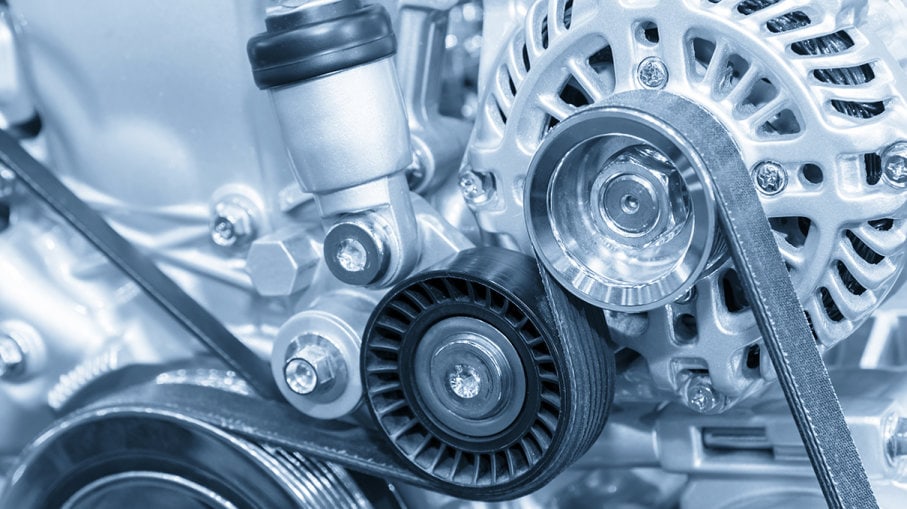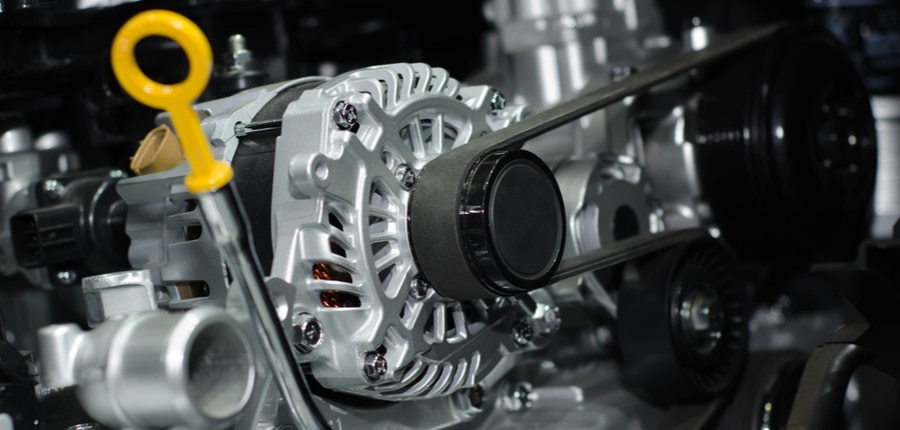The two roles of the alternator are to recharge the vehicle’s battery once it has started the engine and then to meet all of the electrical demands during vehicle operation. It does this by converting some of the engine’s rotating force into electrical current, which is taken off through the accessory belt.
Signs that an alternator might need to be replaced are: system voltage is low, particularly with a lot of accessories on; the battery warning light is on; or the battery is discharged. Other signs can be unusual engine or belt noise and sometimes burning smells.
If a vehicle starts slowly or has a dead battery, it’s normal to have a charging system check done, which tests the battery and the alternator to see which one is the problem.
Typically, this is about a quarter-hour labor charge; $25 to $40 in most places. Many parts stores are also able to test batteries and alternators, often at no charge.
Costs of Alternator Replacement
A rough estimate for the cost of replacing an alternator is about $450, though there are usually many options available.
Parts costs can vary widely. A typical aftermarket alternator, new or remanufactured, can vary from $150 to $300. New OE alternators through a dealership range from $400 to $600 on average.
Most alternators are easily accessible, being typically on the side of the engine near the top. They generate heat as they work, and they are usually put in a position where they have good airflow.
This leads to a common labor time for replacement of about an hour, though there are a few vehicles where significantly more time is needed. Most often, labor on an alternator replacement is billed at book time.
For some specific alternator repair cost examples, assuming a $150 per hour labor rate:
| Car Model | Labor Time & Cost | Aftermarket Alternator's Cost (Excl. Labor) | Factory Alternator Cost (Excl. Labor) |
|---|---|---|---|
| 2010 Toyota Camry (2.5l engine) | $150 (1 hr) | $210 for a remanufactured Denso alternator | $675 |
| 2011 Dodge Journey (3.6l engine) | $210 (1.4 hrs) | $275 for a remanufactured Mopar alternator | $507 |
| 2010 Chevrolet 1500 truck | $90 (0.6 hrs) | new AC Delco alternator is $225 | $569 |
Remanufactured vs. New – Which To Choose?
Most shops would recommend a new alternator, as they have the best reliability. Many times, however, depending on the vehicle, there is an abundance of remanufactured alternators available, while new ones can be harder to source.
On the common models, the prices are often pretty close for either type, but on others, there can be a significant price difference. As long as a good warranty is available, a remanufactured alternator can be a good choice.
Remanufacturing thoroughness does vary, but most of the time, there is a good chance that a remanufactured alternator will last as long as a new one. Ideally, the remanufacturing process replaces all the parts in the alternator that are subject to wear.

Common Alternator Failures
Fortunately, alternator failures are fairly easy to diagnose. They are designed to keep the operating voltage within a certain range under all loads when the vehicle is running, and checking the voltage and the voltage under load is a simple way to verify whether the alternator is working or not.
Of course, all the normal things associated with an electrical diagnosis should be done during a test. The battery should be fully charged, the connections verified, and the fuses related to the charging system (if any) checked.
The basic wearing part on an alternator is the brushes; these will slowly wear through use and eventually begin to lose contact.
When this happens, alternator output and system voltage drop. Most vehicles have a battery light that will come on when the alternator output drops below the level that keeps the battery charged.
There has been regular controversy in the repair industry as to why the alternator warning light displays a picture of the battery rather than an alternator. Perhaps the best explanation is that an alternator is harder to depict.
Alternators can gradually lose output capacity, and early signs of failure are sometimes that a vehicle with all loads on (lights, AC, blower, etc.) will have a problem with dimming lights or low voltage if there is a volts gauge on the instrument cluster. They can also go out suddenly if the voltage regulator or internal circuits that feed the voltage regulator fail.
Another less common problem is the diodes failing, which are built into the alternator. Diodes convert the AC current the alternator produces into the DC current that the vehicle uses.
If one fails, then the current supplied isn’t smooth DC current but partially AC current. This can cause a variety of unusual electrical issues, but it’s also easily diagnosed.
A diode is also like a one-way valve in the electrical system; on rare occasions, they fail in a way that bleeds current back through the system and can discharge the battery.
Other Things to Consider When Replacing the Alternator

In order to replace the alternator, the serpentine belt must be removed. If there are any indications that the belt should be replaced (if it’s showing cracks, if the rubber is old and hard, etc.), then a good time to do it is when replacing the alternator. Giving the various pulleys a quick spin by hand is also customary while the belt is off, to see if the bearings are running smoothly.
A failing alternator can discharge the vehicle battery. If a battery is in marginal condition, recharging can place a lot of stress on it, and it might not be reliable.
A new alternator has to work harder to keep a marginal battery in shape, and this can place it under unwanted stress. It’s common that, when in doubt, a new battery would be recommended along with an alternator replacement. If that isn’t done, it’s still best that the battery be fully charged before a new alternator is installed.
On rare occasions, wiring problems can prevent the normal operation of an alternator. The diagnosis of wiring faults is usually done at an hourly rate, and it’s usually not possible to say in advance how long it might take to diagnose and repair a wiring issue.
Most of the time, an hour is sufficient. On newer vehicles, a dealership would have an advantage, having the best access to wiring diagrams, diagnostic procedures, and proprietary software that allows access to all the necessary module data and functions.
FAQ
No, not easily. Even a dome light left on can cause a discharged battery. The first step is to charge the battery and test it. The second step is to test the alternator output once the battery is charged.
Not for very long. If the alternator isn’t producing current, then it must be drawn off the battery, and the car will shut down once the battery is depleted. With all loads off (lights, radio, etc.), that might allow an hour or less of driving. A modern vehicle with electric power steering shouldn’t be driven with a bad alternator.
Under ordinary use and wear and tear, an alternator should last between 100,000 and 150,000 miles. Of course, being an electrical part, sudden, unexplained failure at any mileage is possible.
No, there is no ordinary alternator maintenance. If a vehicle isn’t driven very often though, the best thing to keep the alternator from stress is to use a small battery tender to keep the charge up, which takes a lot of the load off the alternator.
